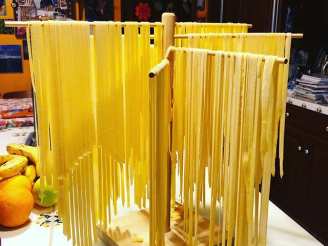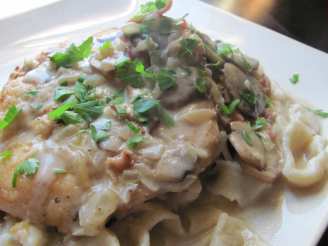Perfect Egg Pasta

- Ready In:
- 35mins
- Ingredients:
- 6
- Serves:
-
8
ingredients
- 4 large eggs
- 2 tablespoons water
- 1 tablespoon olive oil
- 1 3⁄4 cups all-purpose flour
- 1 3⁄4 cups semolina, four
- 3⁄4 teaspoon table salt
directions
- Place eggs, water, oil, flour and salt in mixing bowl.
- Using flat beater (on KA)and mix for 30 seconds on speed 2.
- Exchange flat beater for dough hook, turn speed to 2 and knead for two minutes (or knead by hand).
- Remove dough from bowl and hand knead for 1 to 2 minutes.
- Shape the dough into a log and cut into pieces about 1/2 inch thick.
- Flatten each piece slightly and feed the dough through the pasta roller, following the manufacturers recommended settings.
- Repeat this process several times or until dough is smooth and pliable.
- To make spaghetti, linguine or fettuccine cut the sheets following the manufactures seettings.
- Lightly dust pasta with flour while rolling and cutting to aid in drying and separation.
- Allow the pasta to rest for at least 30 minutes before cooking to relax the gluten.
- Pasta can also be dried or frozen for future use.
- To dry, lay strands of pasta in a single layer on a towel or drying rack and completely air dry before storing in an airtight container.
- To freeze, let pasta air dry for one hour before freezing in an air tight container. It is not necessary to sparate strands of pasta before freezing, just dust with flour and form into 'nests'.
- To Cook:.
- Add 2 teaspoons salt and 1 tablepoon oil (optional) to 6 quarts boiling water. Gradually add pasta and continue to boil until until pasta is 'al dente' or slightly firm to the bite, 5 or 6 minutes for fresh pasta and 6 or 7 minutes for dry or frozen. Pasta floats to the top of the water while cooking, so gently stir occasionally.
- Drain pasta in a colander and serve . . . DO NOT RINSE!
Questions & Replies
Got a question?
Share it with the community!
Reviews
Have any thoughts about this recipe?
Share it with the community!
RECIPE SUBMITTED BY
Galley Wench
Oro Valley, Arizona
"Life is not a journey to the grave with the intention of arriving safely in a pretty and well preserved body, but rather to skid in broadside . . . Chardonnay in one hand . . .chocolate in the other; the body thoroughly used up, totally worn out and screaming "WOO-HOO, what a ride!!"



